Intro
This thread aims to loosely compare lumen output in the various fluorescent lighting systems, and later I will cover the issue of temperature vs lumen output. I've brought this up a few times and people seem quite surprised, so it deserves some coverage. Strangely, it was mentioned in one of Hydro-Soil's first pll threads, I think knna raised it. But I sort of forgot about it and recently rediscovered the importance of maintaining the correct temperature for maximum lumen output.
I will try to keep it simple as possible and I must note - I'm no brainiac. I am not a lighting expert and a lot of my opinions here-in are based only on what I've read. By all means, point out any inconsistencies, please. I haven't used every type of lighting so figures is all I can go off. Use this as a starting point, or a continuation point for your own research.
Also, some of the information was pretty hard to find and as such, may be outdated, but generally it seems on the level to me. In particular, some stuff is from Advanced Lighting Guidelines (1993) (download button top left) which has since been updated to a 2009 version. If anyone has the 2009 version, I would be very grateful for a link or PM, thanks.
Pl-l is briefly covered in there - who knew that they've been around since (pre?) 1993?! lol...17 years? This leads me onto the next point - it was hard enough finding this data for regular fluoros, so pl-l won't be covered much. It's covered elsewhere and suffice to say that it's the best overall. This is mostly a best-of-the-rest.
Finally...."lumens". As we all know, they aren't the most accurate measurement for actually growing plants. It's the best way we have though, and I think it's fair enough to compare fluorescent lights as a group, via their lumens. No arguing or the ninja throwing stars come out. Rightio then, glad we're all agreed!
Rightio then, glad we're all agreed!
Lumens Per Watt
Different fluorescent lighting will have varying lumens per watt. In my opinion, this is the single most important figure in choosing a lighting system. The main reason is to do with efficiency which is to do with heat. I'm not a master of all the terms like efficacy etc so this is laymen's language.
Now, first we must cover the idea of energy. I don't know how well you remember school - I was pretty high and didn't pay much attention to the stuff that is now important to me! But little bits float back into memory. Like, energy isn't magic. It can't just appear or disappear to thin air. It is just there, and changes form, I guess you could say. So if the energy is coming down the line, it's there, and it's not going to disappear, it's going to change form to some other kind of energy.
So we have X amount of power coming down our wires and into our grow lights. This gets broken into two basic forms - useful energy, and wasted energy. If we look at an electric heater - it's energy get's broken up this way too. Everything does. But the heater is designed to put out heat. So any heat it gives off is useful energy. See the bars of the heater glowing? That is light - which in this case, is wasted energy.
In lights, this division is the complete opposite. Light output is looked at as our useful energy, and heat is wasted energy, because we only want the light. The excess energy can also be shown as an electromagnetic field, but that's out of my scope. A proper setup aims to avoid electromagnetic fields so I think we can say the bulk of it is shown as heat. Otherwise it's unknown to me how much of a factor that is exactly. I just presume it's mostly heat.
Sort of summarisation
Thusly and so forth and whatnot, this means that a light with a higher lumen per watt rating is putting out more light, and less heat - just what we want. Gosh, it's all so simple now isn't it? Well, as usual, no it frigging isn't so I have to type another gotdamn book's worth to explain that!
Most people when calculating lumens per watt will take the "initial lumens" rating, and divide it by the "real wattage". I do this myself and quite often these are the only numbers available to us. The problem with this is that we have the "equivalent wattage" that everyone knows to ignore, and what everyone calls "real or true or actual wattage", but then there is another wattage, which is actually realer and truer than all those who stood before.
This is the wattage that one should use in lumen per watt calculations for a more accurate representation of heat vs light. I would like to present to you the following webpage with a great breakdown of everything we need to know in a general outline stylee. Click.
Now, I'm not dead certain how to read this, but I take it as the wattage on the right column is the real-world wattage which I just referred to. The right hand lumens is a real-world measurement of it with a reflector/luminaire. Would we all agree? I hope so because then I can say that the LPW listed is, for most of us, a very accurate indication of the true lumens per watt, versus using the left hand columns.
Now, this kind of data isn't easily available for all lights. We want to keep things simple and we all smoke a lot of weed, so by all means, I think using the traditional lumens divided by the so called "real" wattage is a close enough indication for most people, however I just wanted to cover that for people interested in a more accurate figure. If I'm even reading it right, lulz
You will notice the CFLs have both magnetic and electronic Type ballasts. This obviously has a great impact on things as shown by the figures. This explains the inconsistencies found regarding heat output between varying CFLs. If anyone remembers Grouchy's dissection of a CFL, I would assume that was an electronic ballasted CFL, explaining the low heat savings from remoting the ballast.
It also explains that, in general, CFLs are not easier to cool than other fluoros. Here is a further chart comparing lights on a wider scale to close this party down:
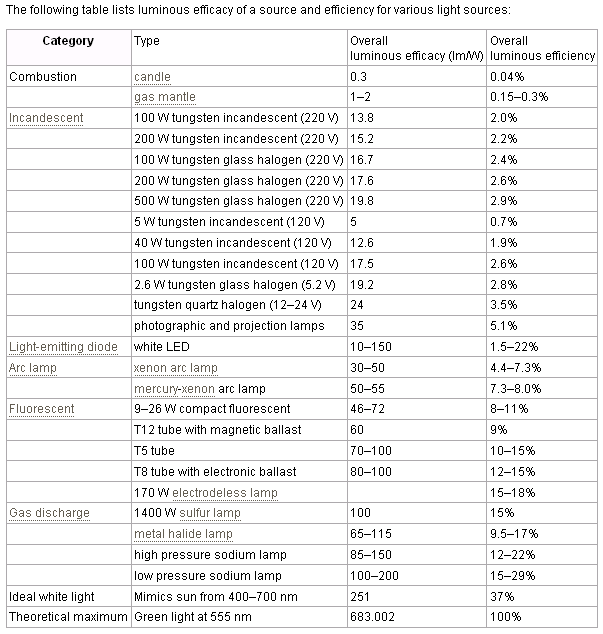
Right then.
How to get the most out of your fluoro lumens
It's important to be aware that your fluoro's lumen output is dependant on a few things, but I will talk about ambient heat. It's very easy to suffer a large lumen loss if the temps are not in range. Each fluoro style can have a different optimal temp.
Lets cover PLL first:
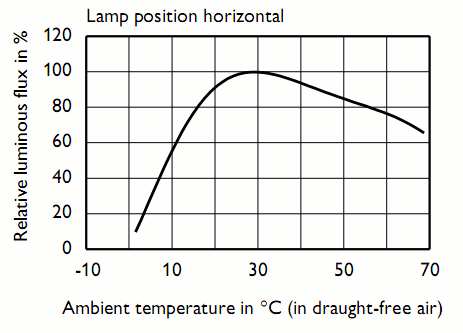
Flip back to the last quote. Remember this bit?
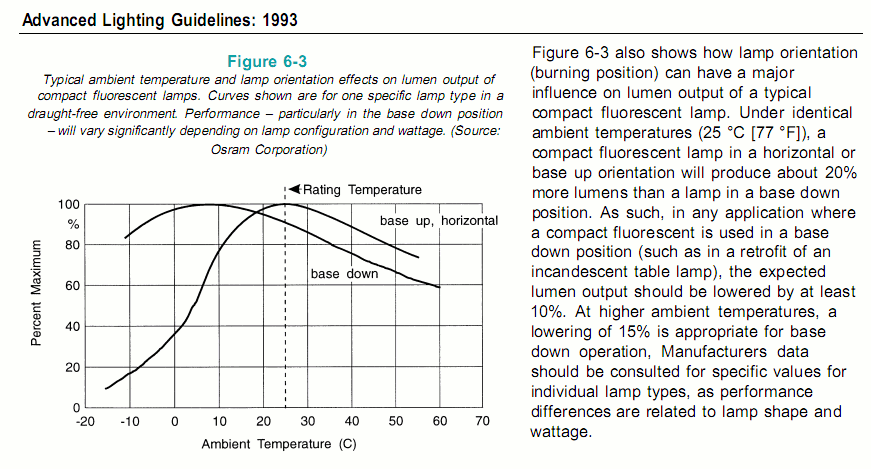
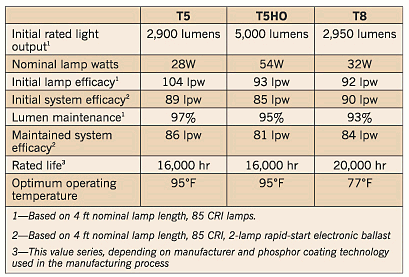
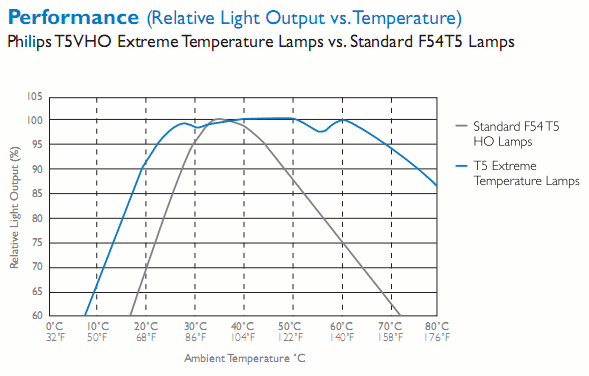
PLL - 25º C - 77º f
CFL - 25º C - 77º f
T8 & T12 - 25º C - 77º f
T5 & T5HO - 35º C - 95º f
See anything standing out? That's right - I've got a boner from talking about fluoros so much, I apologise. But also, the T5s need significantly higher heat to achieve their rated lumens. I did say in the pll club that T5s are a poor choice for growing for this reason. I take it back, but only in part. Ultimately it depends on the specific setup. I think the important thing is to just know the differences, and work with them so they work in your favour.
Makes sense? I hope it helps maximise your chosen lights.
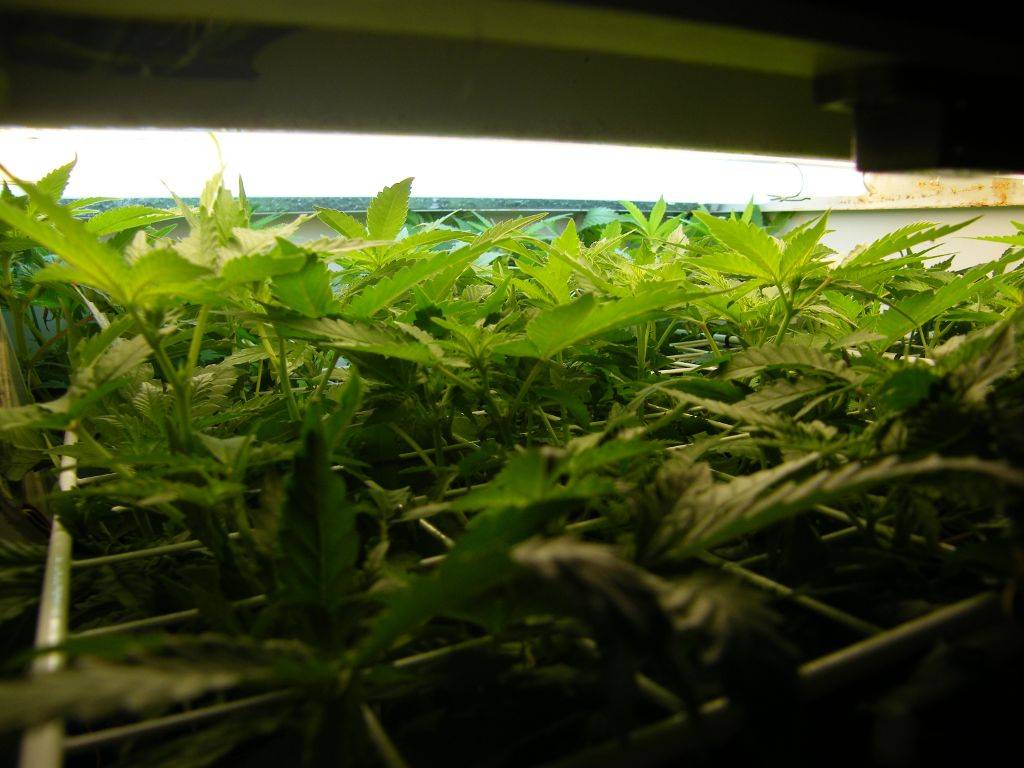
Smoke weed every day. Peace.
This thread aims to loosely compare lumen output in the various fluorescent lighting systems, and later I will cover the issue of temperature vs lumen output. I've brought this up a few times and people seem quite surprised, so it deserves some coverage. Strangely, it was mentioned in one of Hydro-Soil's first pll threads, I think knna raised it. But I sort of forgot about it and recently rediscovered the importance of maintaining the correct temperature for maximum lumen output.
I will try to keep it simple as possible and I must note - I'm no brainiac. I am not a lighting expert and a lot of my opinions here-in are based only on what I've read. By all means, point out any inconsistencies, please. I haven't used every type of lighting so figures is all I can go off. Use this as a starting point, or a continuation point for your own research.
Also, some of the information was pretty hard to find and as such, may be outdated, but generally it seems on the level to me. In particular, some stuff is from Advanced Lighting Guidelines (1993) (download button top left) which has since been updated to a 2009 version. If anyone has the 2009 version, I would be very grateful for a link or PM, thanks.
Pl-l is briefly covered in there - who knew that they've been around since (pre?) 1993?! lol...17 years? This leads me onto the next point - it was hard enough finding this data for regular fluoros, so pl-l won't be covered much. It's covered elsewhere and suffice to say that it's the best overall. This is mostly a best-of-the-rest.
Finally...."lumens". As we all know, they aren't the most accurate measurement for actually growing plants. It's the best way we have though, and I think it's fair enough to compare fluorescent lights as a group, via their lumens. No arguing or the ninja throwing stars come out.
Lumens Per Watt
Different fluorescent lighting will have varying lumens per watt. In my opinion, this is the single most important figure in choosing a lighting system. The main reason is to do with efficiency which is to do with heat. I'm not a master of all the terms like efficacy etc so this is laymen's language.
Now, first we must cover the idea of energy. I don't know how well you remember school - I was pretty high and didn't pay much attention to the stuff that is now important to me! But little bits float back into memory. Like, energy isn't magic. It can't just appear or disappear to thin air. It is just there, and changes form, I guess you could say. So if the energy is coming down the line, it's there, and it's not going to disappear, it's going to change form to some other kind of energy.
So we have X amount of power coming down our wires and into our grow lights. This gets broken into two basic forms - useful energy, and wasted energy. If we look at an electric heater - it's energy get's broken up this way too. Everything does. But the heater is designed to put out heat. So any heat it gives off is useful energy. See the bars of the heater glowing? That is light - which in this case, is wasted energy.
In lights, this division is the complete opposite. Light output is looked at as our useful energy, and heat is wasted energy, because we only want the light. The excess energy can also be shown as an electromagnetic field, but that's out of my scope. A proper setup aims to avoid electromagnetic fields so I think we can say the bulk of it is shown as heat. Otherwise it's unknown to me how much of a factor that is exactly. I just presume it's mostly heat.
Sort of summarisation
Thusly and so forth and whatnot, this means that a light with a higher lumen per watt rating is putting out more light, and less heat - just what we want. Gosh, it's all so simple now isn't it? Well, as usual, no it frigging isn't so I have to type another gotdamn book's worth to explain that!
Most people when calculating lumens per watt will take the "initial lumens" rating, and divide it by the "real wattage". I do this myself and quite often these are the only numbers available to us. The problem with this is that we have the "equivalent wattage" that everyone knows to ignore, and what everyone calls "real or true or actual wattage", but then there is another wattage, which is actually realer and truer than all those who stood before.
This is the wattage that one should use in lumen per watt calculations for a more accurate representation of heat vs light. I would like to present to you the following webpage with a great breakdown of everything we need to know in a general outline stylee. Click.
Now, I'm not dead certain how to read this, but I take it as the wattage on the right column is the real-world wattage which I just referred to. The right hand lumens is a real-world measurement of it with a reflector/luminaire. Would we all agree? I hope so because then I can say that the LPW listed is, for most of us, a very accurate indication of the true lumens per watt, versus using the left hand columns.
Now, this kind of data isn't easily available for all lights. We want to keep things simple and we all smoke a lot of weed, so by all means, I think using the traditional lumens divided by the so called "real" wattage is a close enough indication for most people, however I just wanted to cover that for people interested in a more accurate figure. If I'm even reading it right, lulz
You will notice the CFLs have both magnetic and electronic Type ballasts. This obviously has a great impact on things as shown by the figures. This explains the inconsistencies found regarding heat output between varying CFLs. If anyone remembers Grouchy's dissection of a CFL, I would assume that was an electronic ballasted CFL, explaining the low heat savings from remoting the ballast.
It also explains that, in general, CFLs are not easier to cool than other fluoros. Here is a further chart comparing lights on a wider scale to close this party down:
Right then.
How to get the most out of your fluoro lumens
It's important to be aware that your fluoro's lumen output is dependant on a few things, but I will talk about ambient heat. It's very easy to suffer a large lumen loss if the temps are not in range. Each fluoro style can have a different optimal temp.
Lets cover PLL first:
- PLL
Take what you want from that but in the interests of keeping things simple, lets focus on the ambient temp around the bulb tip (horizontal orientation). We can't measure the cold spot ourselves as it's inside the bulb. So here is the chart for the ambient temp:1.2.1 Cold-spot technology (pdf)
The luminous flux of the MASTER PL-L lamp is governed by the temperature of the coldest spot in the discharge tube. In the base-up and horizontal burning position the so-called cold-spot is located at the lamp head. In the base-down burning position the cold-spot is located inside the lamp base (cannot be measured). The maximum light output is reached at a cold-spot temperature of 45 °- 50 °C, corresponding to a lamp ambient temperature of about 25 °C. At lower and at higher cold-spot temperatures the luminous flux decreases. For a cold-spot temperature between about 32 °C and 72 °C the luminous flux will be greater than or equal to 80% of its optimum. Cold-spot temperatures > 72 °C can occur in completely closed, compact luminaires. Cold-spot temperatures < 32 °C can occur in luminaires which are excessively ventilated and/or at low ambient temperatures. A luminous flux lower than 80% of the optimum can lead to slight changes in light colour.
Flip back to the last quote. Remember this bit?
So, keep this in mind when designing your cab. It's not hard to picture a situation where one loses a lot of lumens due to poor heat management, be it too much cooling, or not enough. Same goes for the other lights and here they are...(loss) can occur in
luminaires which are excessively ventilated and/or at low ambient temperatures.
- CFL
- T-5 / T-5 HO / T-8 (T-12 is the same as T-8)
- T5HO & T5VHO (not sure if all T5VHO perform like this, I just found it in a pdf for a specific bulb from Philips)
- Summary of optimal lumen temps
PLL - 25º C - 77º f
CFL - 25º C - 77º f
T8 & T12 - 25º C - 77º f
T5 & T5HO - 35º C - 95º f
See anything standing out? That's right - I've got a boner from talking about fluoros so much, I apologise. But also, the T5s need significantly higher heat to achieve their rated lumens. I did say in the pll club that T5s are a poor choice for growing for this reason. I take it back, but only in part. Ultimately it depends on the specific setup. I think the important thing is to just know the differences, and work with them so they work in your favour.
Makes sense? I hope it helps maximise your chosen lights.
Smoke weed every day. Peace.

Last edited:


